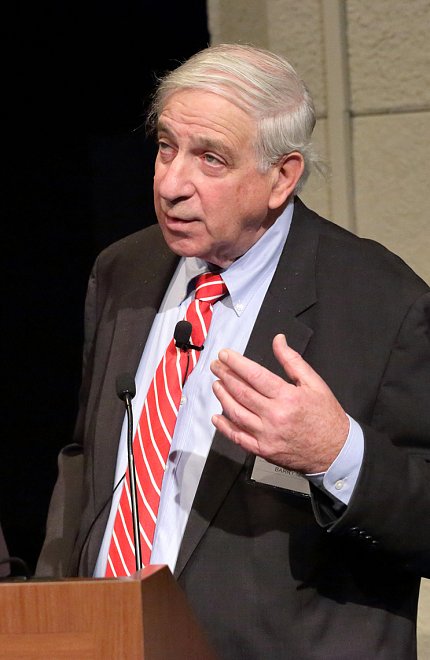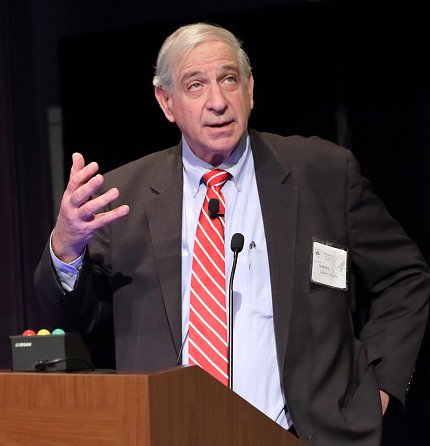Heart Health
Advances in Clinical Research Have Made HCM Highly Treatable

Cardiac arrest hits without warning and is particularly tragic when it kills a seemingly healthy young person. One underlying cause of sudden cardiac death is hypertrophic cardiomyopathy (HCM), a genetic disease that is highly treatable today. Yet HCM remains the most common cause of sudden cardiac death in young people, including competitive athletes.
“HCM has become a treatable disease, compatible with low mortality and extended, normal longevity,” said Dr. Barry Maron, a leading expert on HCM and director of the Hypertrophic Cardiomyopathy Center at the Minneapolis Heart Institute Foundation. He spoke at a recent Grand Rounds Great Teachers lecture in Lipsett Amphitheater. “This is a source of reassurance to patients who have this disease who very often still believe that it’s grim, unrelenting and ultimately going to kill them.”
HCM thickens the heart walls, restricting blood flow. Some who have it are asymptomatic; others may experience dizziness, shortness of breath, chest pain and/or arrhythmias.
The disease affects at least 1 in 500 Americans. While some 700,000 people in the U.S. have HCM, including some who may be at increased risk of progressive heart failure and sudden death, many are unaware they carry the gene. But many patients with HCM lead long lives without incident or intervention.
“If you’ve reached the age of 60, 65 and nothing has happened, it’s as if the disease has declared itself at this point and the event rate is very low, in fact less than the general population,” said Maron, a former senior investigator at NHLBI. “Sudden death due to HCM is rare in this age group, particularly not after age 70, and there’s little reason to consider primary intervention.”
For those who require treatment, the range of options includes implantable cardioverter defibrillators (ICD) that abort life-threatening arrhythmias; septal myectomy to surgically reduce muscle thickening; medications; and transplant. These treatments can reverse heart failure and often allow patients to return to normal activity, said Maron.
Septal myectomy is a procedure developed at NIH 55 years ago. “The mortality rate deserves comment because myectomy operations have become the safest open-heart procedure we have, in experienced hands,” said Maron. The operation improves quality of life, survival and possibly decreases risk for sudden death.
Scans such as MRI and CMR (cardiac MRI) can show morphology and help identify patients who need intervention. Still, HCM is heterogeneous and highly unpredictable, said Maron. One 18-year-old asymptomatic patient seemed low-risk though a CMR showed some wall scarring, which can be a source of arrhythmias. His mother insisted her son get an ICD implant. Then, 9 months later, the device stopped an arrhythmia and saved him.

Another example highlighting the unpredictability of HCM and the value of primary prevention is a patient who got an ICD implant after his brother died of the disease. During sleep 5 years later, only seconds after an episode of tachycardia, a shock restored the patient’s heart rhythm. Then 9 years later, at age 50, he received a second life-saving shock and has lived without incident for the past decade.
“There’s a certain degree of predictability for which patients are at risk,” said Maron, “but the timing for these events is unpredictable.”
Patients have a higher mortality risk if they have a family history of HCM, wall scarring or massive hypertrophy (thickness). Patients with left ventricular aneurysms represent another high-risk group. And while younger people tend to have a more progressive form of HCM, today’s treatments end up creating a low mortality rate for younger patients as well.
Fifty years ago, the mortality rate for HCM patients was 6 percent per year. Today, if patients receive proper treatment, said Maron, the mortality is less than 1 percent.
Genetic research has played a role in understanding HCM. Investigators have identified 11 genes and nearly 2,000 mutations, said Maron. But given the disease’s heterogeneous properties, even using genetic markers makes it hard to predict risk. Maron credits decades of clinical research with reducing HCM mortality rates and extending healthy lifespans.
“I believe very strongly that this is a clinical initiative,” said Maron. Genetic research has contributed to understanding the basic molecular substrate for the disease and genetic testing can help exclude some family members from further evaluation. “But in terms of prognosis and treating patients, the clinicians have saved a lot of lives.”
